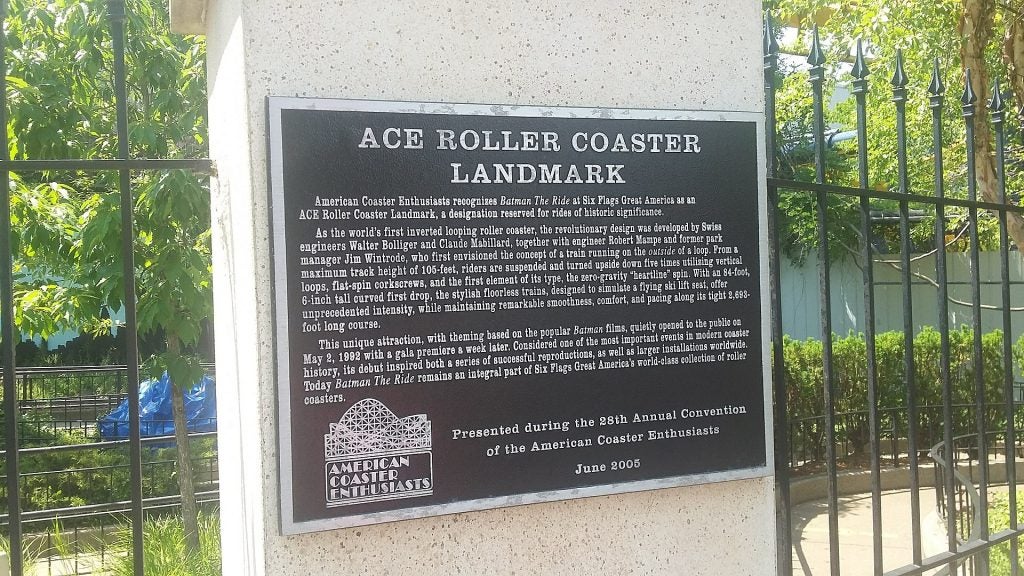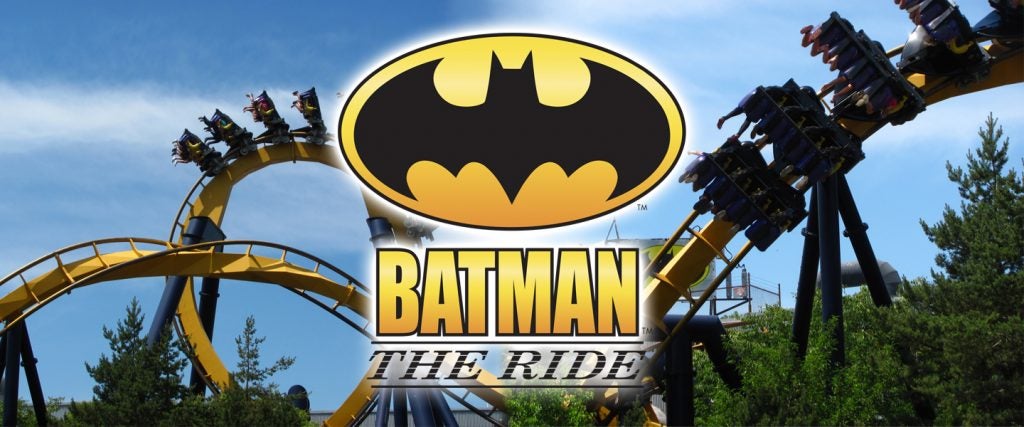I still remember that sound.
All roller coasters make noise, of course, but with Six Flags’ Batman: The Ride, there wasn’t that traditional, train-like ratcheting you normally hear. Instead, there seemed to be something more animalistic about the sound it made — it was almost like a roar.
That’s what you heard just walking by Batman: The Ride, but once you entered the queue, things got even better. A full-size Batmobile from the 1989 Batman film sat parked out front, and the entire line was dressed like it was directly out of Tim Burton’s German Impressionist Gotham. As you progressed, you passed by an actual Gotham City Police car, which had been run into a fire hydrant and was riddled with bullet holes. Then you entered into the industrial “Gotham Public Works” building, as Danny Elfman’s timeless Batman theme cued up. Finally, you’d discover the Batcave, where a replica of Michael Keaton’s Batman suit hung behind glass.
It was the perfect buildup to Batman: The Ride, which, in 1992, was an entirely new kind of theme park experience. Rather than sit in a traditional roller-coaster car atop a track, Batman: The Ride’s track was above you, and once you were strapped in, your feet dangled freely as you rode. As it began, the ride twisted, turned, looped and corkscrewed at 50 miles per hour over 2,700 feet of track before rushing you back into the Batcave, where you’d likely run out of the ride and right back in the line.
When it opened on May 9, 1992 at Six Flags Great America in Gurnee, Illinois, Batman: The Ride was the world’s first inverted roller coaster. It was also just a couple of years after Warner Bros. partnered with Six Flags, so Batman: The Ride was also the first immersive ride experience of its kind outside of Disney. In time, it would be awarded a coveted “Coaster Landmark” status by the American Coaster Enthusiasts, and would spawn countless other inverted coasters.

It all began with one man, though, and it wasn’t Bruce Wayne or Tim Burton. It was Jim Wintrode, who, in the late 1980s and early 1990s, was the general manager of Six Flags Great America. To this day, he still considers Batman: The Ride to be his greatest professional achievement.
Upon the ride’s 30th anniversary — it still, in fact, is going strong at many of the Six Flags parks — I recently got a chance to catch up with Wintrode to talk about how he came up with the idea for an inverted roller coaster, why he wasn’t exactly thrilled at first to share it with Warner Bros. and Batman and the exhilaration he felt during his maiden voyage on Batman: The Ride.
When did you begin working with Six Flags?
I started in 1972 as director of finance for two small parks they had in California. I spent a couple of years there, then a couple of years at the corporate offices in Los Angeles. Then I was director of finance at the Georgia park, then the general manager at the St. Louis park. In 1987, I moved to Gurnee, Illinois as the general manager of Six Flags Great America.

Where did the inverted roller coaster idea come from?
When I was in Atlanta, I fell in love with roller coasters. I loved developing them, and I love to ride them too. When I got to Gurnee, I was the boss, so I had a lot of freedom to do different things.
Back in the late 1980s, some ride manufacturer — I don’t remember who it was — developed a suspended roller coaster, which is a roller coaster that hung from the track and had a car below. Suspended coaster could swing you side-to-side, but it couldn’t go through a loop. To do that, you had to have a fixed vehicle on the track. So, the first time I rode one of those suspended coasters, I thought to myself, “Gee, it’d be great if we could put these things through loops.”

I spoke to several different manufacturers about the concept, but they couldn’t do it. Then my mechanical manager at Great America, Bob Mampe, introduced me to Bolliger & Mabillard, a roller-coaster manufacturer in Switzerland. They were a brand new company in 1988, and their first ride was Iron Wolf, a stand-up roller coaster we did at Six Flags Great America. That opened in 1990, and while they were working on it, I was talking to [co-founder] Walter Bolliger about this suspended coaster idea and trying to find a way to design one that could go through loops. I don’t recall how much later — maybe it was a couple of months — but later on, we spoke and he said, “We can do it.”
How long did it take to build the ride?
A roller coaster like that takes a couple of years to build. Those conversations about the ride started around the summer of 1990. Shortly after Walter said they could build it, he showed me a couple of designs for how it would work, and I approved it. I had total faith in them.
They were a small company, just Walter [Bolliger] and Claude Mabillard and a couple of engineers they had working for them. In the fall of 1991, I flew over to Switzerland to see the design of the vehicle itself, including the restraint system, which I was concerned about. I got to check it out, sit in the vehicle and look at the restraint system. I said, “Yeah, it’s good,” and that was about it. The concept was all new, and it was the most expensive project we’d had up until that — about $7 million, I think — but I don’t remember there being any major issues with it.

When did it become Batman: The Ride?
Warner Bros. got involved with Six Flags around 1990 or 1991. A guy named Bob Pittman became the CEO and my boss. It was he and his group that made the decision to make the ride themed around Batman, which was their signature product.
Honestly, when it became the Batman ride, I wasn’t happy about it at first. When Warner Bros. came in, the ride had already been purchased. It wasn’t named yet, but they kind of came in at the last minute and took over the project, particularly from a marketing standpoint by deciding that it was going to be part of the whole “Batman” identity. So, as the general manager who’d been involved since the beginning, I wasn’t exactly happy.
In retrospect, of course, it was a great move. This was around the time of the first Batman movie, so we had tremendous name recognition. We also had a state-of-the-art, never-before-done roller coaster, and giving it the moniker “Batman” just made a lot of sense. There was also a commercial for it using Batman that was a total home run. Eventually, once we got started, I saw the full potential of naming it for Batman, and we were really lucky to have that happen. I guess, sometimes, your ego can just get in the way.
What was it like when the ride opened?
I’ve built quite a few roller coasters, and I always wanted to be the first to ride them. The sandbags [for testing] come off and then I get on. For Batman, Walter happened to be in town, so we rode it together and I was blown away! I couldn’t believe how good the ride was and how cool it was. I was screaming, but not like a typical roller-coaster ride, I was screaming because, after two years overseeing it, it was all just so flipping cool.
From a personal standpoint, it was huge for me. Then, when the general public got to ride it, it was even better. The lines for Batman were hours long — it was the best year Six Flags Great America had ever had up until that point. For the first four years I was there, annual attendance was around 2.5 million. The year of Batman: The Ride, we did 3.1 million. It was a half million increase in a single year — that was unheard of.
How do you feel about Batman: The Ride 30 years later?
At the end of 2003, I retired from Six Flags. I had a good, long career with that company with lots of successes, but Batman: The Ride was the signature event for my entire career. Having had this idea and then taking a chance on B&M to make it happen, then getting to work with them so closely — it was all really exciting. To this day, it’s still the thing I’m most proud of.

